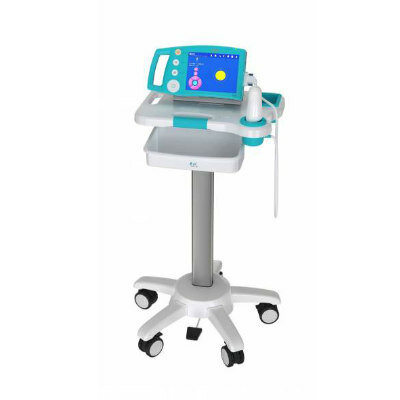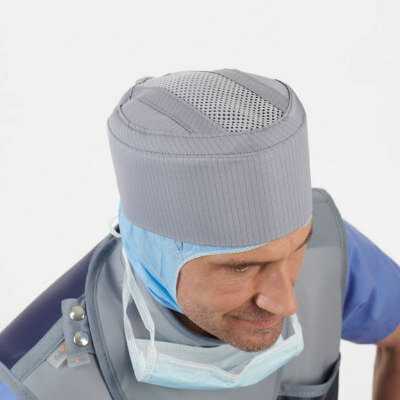Novel Molecular Imaging System Revealed at SNMMI 2016
|
By MedImaging International staff writers Posted on 21 Jun 2016 |

Image: The mobile mini gamma ray camera being evaluated in the clinic (Photo courtesy of the University of Leicester).
A new portable hybrid molecular imaging system that combines optical and gamma imaging and can provide a multi-dimensional view of surface organs has been announced at the annual meeting of the Society of Nuclear Medicine and Molecular Imaging (SNMMI 2016).
The imaging system provides clinicians with molecular data and an optical image of skin, eyes, or other surface organs in a single frame. The scintigraphy part of the system includes a gamma camera that can detect minute radioactive signals from a radionuclide.
The system was developed by researchers at the University of Leicester (Leicester, UK), and at the University of Nottingham (Nottingham, UK). The researchers presented the results of a clinical pilot study using the system in a scientific paper at the SNMMI 2016 meeting.
In the study the researchers performed standard molecular imaging procedures including thyroid or lymphatic system imaging. The researchers then used a 1.5 millimeter-thick scintillator to optimize the image resolution and reduce the acquisition time to less than five minutes. The results showed that the system was very effective for imaging thyroid and lymphatic tissue, and drainage from lacrimal glands, or tear ducts. The imaging system is still in the development stage.
Alan Perkins, PhD, Radiological Sciences, University of Nottingham, said, "This research covers the first patient results obtained with the hybrid optical-gamma camera developed in the UK at the Universities of Leicester and Nottingham. This scanner has hand-held potential and can be used in a variety of settings, including the outpatient clinic, patient bedside, operating theatre and intensive care unit."
Related Links:
University of Leicester
University of Nottingham
The imaging system provides clinicians with molecular data and an optical image of skin, eyes, or other surface organs in a single frame. The scintigraphy part of the system includes a gamma camera that can detect minute radioactive signals from a radionuclide.
The system was developed by researchers at the University of Leicester (Leicester, UK), and at the University of Nottingham (Nottingham, UK). The researchers presented the results of a clinical pilot study using the system in a scientific paper at the SNMMI 2016 meeting.
In the study the researchers performed standard molecular imaging procedures including thyroid or lymphatic system imaging. The researchers then used a 1.5 millimeter-thick scintillator to optimize the image resolution and reduce the acquisition time to less than five minutes. The results showed that the system was very effective for imaging thyroid and lymphatic tissue, and drainage from lacrimal glands, or tear ducts. The imaging system is still in the development stage.
Alan Perkins, PhD, Radiological Sciences, University of Nottingham, said, "This research covers the first patient results obtained with the hybrid optical-gamma camera developed in the UK at the Universities of Leicester and Nottingham. This scanner has hand-held potential and can be used in a variety of settings, including the outpatient clinic, patient bedside, operating theatre and intensive care unit."
Related Links:
University of Leicester
University of Nottingham
Latest Nuclear Medicine News
- New SPECT/CT Technique Could Change Imaging Practices and Increase Patient Access
- New Radiotheranostic System Detects and Treats Ovarian Cancer Noninvasively
- AI System Automatically and Reliably Detects Cardiac Amyloidosis Using Scintigraphy Imaging
- Early 30-Minute Dynamic FDG-PET Acquisition Could Halve Lung Scan Times
- New Method for Triggering and Imaging Seizures to Help Guide Epilepsy Surgery
- Radioguided Surgery Accurately Detects and Removes Metastatic Lymph Nodes in Prostate Cancer Patients
- New PET Tracer Detects Inflammatory Arthritis Before Symptoms Appear
- Novel PET Tracer Enhances Lesion Detection in Medullary Thyroid Cancer
- Targeted Therapy Delivers Radiation Directly To Cells in Hard-To-Treat Cancers
- New PET Tracer Noninvasively Identifies Cancer Gene Mutation for More Precise Diagnosis
- Algorithm Predicts Prostate Cancer Recurrence in Patients Treated by Radiation Therapy
- Novel PET Imaging Tracer Noninvasively Identifies Cancer Gene Mutation for More Precise Diagnosis
- Ultrafast Laser Technology to Improve Cancer Treatment
- Low-Dose Radiation Therapy Demonstrates Potential for Treatment of Heart Failure
- New PET Radiotracer Aids Early, Noninvasive Detection of Inflammatory Bowel Disease
- Combining Amino Acid PET and MRI Imaging to Help Treat Aggressive Brain Tumors
Channels
MRI
view channel
PET/MRI Improves Diagnostic Accuracy for Prostate Cancer Patients
The Prostate Imaging Reporting and Data System (PI-RADS) is a five-point scale to assess potential prostate cancer in MR images. PI-RADS category 3 which offers an unclear suggestion of clinically significant... Read more
Next Generation MR-Guided Focused Ultrasound Ushers In Future of Incisionless Neurosurgery
Essential tremor, often called familial, idiopathic, or benign tremor, leads to uncontrollable shaking that significantly affects a person’s life. When traditional medications do not alleviate symptoms,... Read more
Two-Part MRI Scan Detects Prostate Cancer More Quickly without Compromising Diagnostic Quality
Prostate cancer ranks as the most prevalent cancer among men. Over the last decade, the introduction of MRI scans has significantly transformed the diagnosis process, marking the most substantial advancement... Read moreUltrasound
view channel
Deep Learning Advances Super-Resolution Ultrasound Imaging
Ultrasound localization microscopy (ULM) is an advanced imaging technique that offers high-resolution visualization of microvascular structures. It employs microbubbles, FDA-approved contrast agents, injected... Read more
Novel Ultrasound-Launched Targeted Nanoparticle Eliminates Biofilm and Bacterial Infection
Biofilms, formed by bacteria aggregating into dense communities for protection against harsh environmental conditions, are a significant contributor to various infectious diseases. Biofilms frequently... Read moreNuclear Medicine
view channel
New SPECT/CT Technique Could Change Imaging Practices and Increase Patient Access
The development of lead-212 (212Pb)-PSMA–based targeted alpha therapy (TAT) is garnering significant interest in treating patients with metastatic castration-resistant prostate cancer. The imaging of 212Pb,... Read moreNew Radiotheranostic System Detects and Treats Ovarian Cancer Noninvasively
Ovarian cancer is the most lethal gynecological cancer, with less than a 30% five-year survival rate for those diagnosed in late stages. Despite surgery and platinum-based chemotherapy being the standard... Read more
AI System Automatically and Reliably Detects Cardiac Amyloidosis Using Scintigraphy Imaging
Cardiac amyloidosis, a condition characterized by the buildup of abnormal protein deposits (amyloids) in the heart muscle, severely affects heart function and can lead to heart failure or death without... Read moreGeneral/Advanced Imaging
view channel
New AI Method Captures Uncertainty in Medical Images
In the field of biomedicine, segmentation is the process of annotating pixels from an important structure in medical images, such as organs or cells. Artificial Intelligence (AI) models are utilized to... Read more.jpg)
CT Coronary Angiography Reduces Need for Invasive Tests to Diagnose Coronary Artery Disease
Coronary artery disease (CAD), one of the leading causes of death worldwide, involves the narrowing of coronary arteries due to atherosclerosis, resulting in insufficient blood flow to the heart muscle.... Read more
Novel Blood Test Could Reduce Need for PET Imaging of Patients with Alzheimer’s
Alzheimer's disease (AD), a condition marked by cognitive decline and the presence of beta-amyloid (Aβ) plaques and neurofibrillary tangles in the brain, poses diagnostic challenges. Amyloid positron emission... Read more.jpg)
CT-Based Deep Learning Algorithm Accurately Differentiates Benign From Malignant Vertebral Fractures
The rise in the aging population is expected to result in a corresponding increase in the prevalence of vertebral fractures which can cause back pain or neurologic compromise, leading to impaired function... Read moreImaging IT
view channel
New Google Cloud Medical Imaging Suite Makes Imaging Healthcare Data More Accessible
Medical imaging is a critical tool used to diagnose patients, and there are billions of medical images scanned globally each year. Imaging data accounts for about 90% of all healthcare data1 and, until... Read more
Global AI in Medical Diagnostics Market to Be Driven by Demand for Image Recognition in Radiology
The global artificial intelligence (AI) in medical diagnostics market is expanding with early disease detection being one of its key applications and image recognition becoming a compelling consumer proposition... Read moreIndustry News
view channel
Bayer and Google Partner on New AI Product for Radiologists
Medical imaging data comprises around 90% of all healthcare data, and it is a highly complex and rich clinical data modality and serves as a vital tool for diagnosing patients. Each year, billions of medical... Read more



















